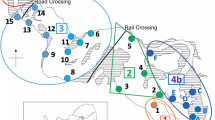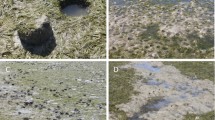Abstract
Seagrasses of the world harbor a rich and varied fauna, but a review of the literature revealed that little has been done to evaluate the ecological importance of nemerteans in such communities. Monostiliferous hoplonemerteans are common inhabitants of some seagrasses, e.g. eelgrass (Zostera), but generally they are seldom collected or identified or are apparently absent in other species such as schoalgrass (Halodule) or turtlegrass (Thalassia). Nineteen species of hoplonemerteans (four families) have been identified from eelgrass beds around the world; they exist mainly as epifauna, and all except two species are probably suctorial feeders. Some palaeonemerteans (2 species) and heteronemerteans (4 species) are also associated with eelgrass, but mainly as infauna. Suctorial nemerteans (4 species in 3 families) from eelgrass beds located along the mid-Atlantic coast of the United States feed in the laboratory on a variety of amphipod species that inhabit eelgrass. Tubicolous species (e.g. Corophium) seem to be preferred. Zygonemertes virescens feeds on nine species of amphipods belonging to six families, and is the only species to feed on isopods (3 species). Analyses of field studies on the occurrence of hoplonemerteans in eelgrass beds in Virginia and New Jersey, along with available information on the food habits of these worms, were used as a basis for demonstrating their potential importance as predators of peracarids in seagrass systems. More careful methods for collecting and identifying worms, continued studies on food preferences and rates of predation, and emphasis on the population dynamics of worms and prey, are recommended in order to evaluate the role of suctorial hoplonemerteans in the ecology of seagrasses.
Similar content being viewed by others
References
Adams, S. M., 1976a. The ecology of eelgrass, Zostera marina (L.), fish communities. I. Structural analysis. J. exp. mar. Biol. Ecol. 22: 269–291.
Adams, S. M., 1976b. The ecology of eelgrass, Zostera marina (L.), fish communities. II. Functional analysis. J. exp. mar. Biol. Ecol. 22: 293–311.
Ansari, Z. A., 1984. Benthic macro & meiofauna of seagrass (Thalassia hemprichii) bed at Minicoy, Lakshadweep. Indian J. mar. Sci. 13: 126–227.
Asmus, H. & R. Asmus, 1985. The importance of grazing food chain for energy flow and production in three intertidal sand bottom communities of the northern Wadden Sea. Helgoländer wiss. Meeresunters. 39: 273–301.
Barnard, J. L., 1970. Benthic ecology of Bahia de San Quintin Baja California. Smithson. Contrib. Zool. No. 44, 60 pp.
Bartsch, I., 1973. Zur Nahrungsaufnahme von Tetrastemma melanocephalum (Nemertini). Helgoländer wiss. Meeresunters. 25: 326–331.
Brunberg, L., 1964. On the nemertean fauna of Danish waters. Ophelia 1: 77–111.
Coe, W. R., 1943. Biology of the nemerteans of the Atlantic coast of North America. Trans. conn. Acad. Arts Sci. 35: 129–327.
Davies, R. W., 1969. The production of antisera for detecting specific triclad antigens in the gut contents of predators. Oikos 20: 248–260.
Davies, R. W., F. J. Wrona & R. P. Everett, 1978. A serological study of prey selection by Nephelopsis obscura Verrill (Hirudinoidea). Can. J. Zool. 56: 587–591.
Davies, R. W., F. J. Wrona & L. Linton 1979. A serological study of prey selection by Helobdella stagnalis (Hirudinoidea). J. anim. Ecol. 48: 181–194.
Feller, R. J., 1986. Immunological detection of Mercenaria mercenaria in a predator and preparation of size-class specific antibodies. Veliger 28: 341–347.
Feller, R. J. & E. D. Gallagher, 1982. Antigenic similarities among estuarine soft-bottom benthic taxa. Oecologia 52: 305–310.
Feller, R. J., G. L. Taghon, E. D. Gallagher, G. E. Kenny & P. A. Jumars, 1979. Immunological methods for food web analysis in a soft-bottom benthic community. Mar. Biol. 54: 61–74.
Fredette, T. J. & R. J. Diaz, 1986. Life history of Gammarus mucronatus Say (Amphipoda: Gammaridae) in warm temperate estuarine habitats, York River, Virginia. J. crust. Biol. 6: 57–78.
Friedrich, H., 1935. Studien zur Morphologie, Systematik und Ökologie der Nemertinen der Kieler Bucht. Arch. Naturgesch., N. F. 4: 293–375.
Gibson, R., 1982. British nemerteans. Cambridge University Press, Cambridge, 212 pp.
Gibson, R. & J. O. Young, 1976. Ecological observations on a population of the freshwater hoplonemertean Prostoma jenningsi Gibson and Young 1971. Arch. Hydrobiol. 78: 42–50.
Gray, C. A. & J. D. Bell, 1986. Consequences of two common techniques for sampling vagile macrofauna associated with the seagrass Zostera capricorni. Mar. Ecol. prog. Ser. 28: 43–48.
Heck, K. L., Jr., 1977. Comparative species richness, composition, and abundance of invertebrates in Caribbean seagrass (Thalassia testudinum) meadows (Panamá). Mar. Biol. 41: 335–348.
Heck, K. L., Jr., 1979. Some determinants of the composition and abundance of motile macroinvertebrate species in tropical and temperate turtlegrass (Thalassia testudinum) meadows. J. Biogeogr. 6: 183–200.
Heck, K. L., Jr. & R. J. Orth, 1980. Structural components of eelgrass (Zostera marina) meadows in the lower Chesapeake Bay — decapod Crustacea. Estuaries 3: 289–295.
Heck, K. L., Jr. & G. S. Wetstone, 1977. Habitat complexity and invertebrate species richness in tropical seagrass meadows. J. Biogeogr. 4: 135–142.
Kikuchi, T., 1966. An ecological study on animal communities of the Zostera marina belt in Tomioka Bay, Amakusa, Kyushu. Publ. Amakusa mar. biol. Lab. 1: 1–106.
Kikuchi, T. & J. M. Pérès, 1977. Consumer ecology of seagrass beds. In C. P. McRoy & C. Helfferich (eds), Seagrass Systems; A Scientific Perspective. Marcel Dekker, NY: 147–193.
Kirsteuer, E., 1963a. Zur Ökologie systematischer Einheiten bei Nemertinen. Zool. Anz. 170: 343–354.
Kirsteuer, E., 1963b. Beitrag zur Kenntnis der Systematik und Anatomie der adriatischen Nemertinen (Genera Tetrastemma, Oerstedia, Oerstediella). Zool. Jb. Anat. Ontog. Tiere 80: 555–616.
Kirsteuer, E., 1967. Marine, benthonic nemerteans: how to collect and preserve them. Am. Mus. Novitates No. 2290, 10 pp.
Kitting, C. L., 1984. Selectivity by dense populations of small invertebrates foraging aming seagrass blade surfaces. Estuaries 7: 276–288.
Lewis, F. G., III & A. W. Stoner, 1983. Distribution of macrofauna within seagrass beds: an explanation for patterns of abundance. Bull. mar. Sci. 33: 296–304.
Lewis, J. B. & C. E. Hollingworth, 1982. Leaf epifauna of the seagrass Thalassia testudinum. Mar. Biol. 71: 41–49.
Marsh, G. A., 1973. The Zostera epifaunal community in the York River, Virginia. Chesapeake Sci. 14: 87–97.
McCaul, W. E., 1963. Rhynchocoela: nemerteans from marine and estuarine waters of Virginia. J. Elisha Mitchell Sci. Soc. 79: 111–124.
McDermott, J. J., 1976. Observations on the food and feeding behavior of estuarine nemertean worms belonging to the order Hoplonemertea. Biol. Bull. 150: 57–68.
McDermott, J. J., 1984. The feeding biology of Nipponnemertes pulcher (Johnston) (Hoplonemertea), with some ecological implications. Ophelia 23: 1–21.
McDermott, J. J. & P. Roe, 1985. Food, feeding behavior and feeding ecology of nemerteans. Am. Zool. 25: 113–125.
McDermott, J. J. & R. L. Snyder, 1987. Food and feeding behavior of the hoplonemertean Oerstedia dorsalis. Hydrobiologia, this volume.
McRoy, C. P. & Helfferich (eds), 1977. Seagrass Ecosystems; A Scientific Perspective. Marcel Dekker, NY, 314 pp.
Nelson, W. G., 1979a. Experimental studies of selective predation on amphipods: consequences for amphipod distribution and abundance. J. exp. mar. Biol. Ecol. 38: 225–245.
Nelson, W. G., 1979b. An analysis of structural pattern in an eelgrass (Zostera marina L.) amphipod community. J. exp. mar. Biol. Ecol. 39: 231–264.
Nelson, W. G., 1980. The biology of eelgrass (Zostera marina L.) amphipods. Crustaceana 39: 59–89.
Nelson, W. G., K. D. Cairns & R. W. Virnstein, 1982. Seasonality and spatial patterns of seagrass-associated amphipods of the Indian River lagoon, Florida. Bull. mar. Sci. 32: 121–129.
Orth, R. J., 1971. Benthic infauna of eelgrass, Zostera marina, beds. M. S. Thesis, University of Virginia, Charlottesville, 78 pp.
Orth, R. J., 1973. Benthic infauna of eelgrass, Zostera marina, beds. Chesapeake Sci. 14: 258–269.
Orth, R. J., K. L. Heck, Jr. & J. van Montfrans, 1984. Faunal communities in seagrass beds: a review of the influence of plant structure and prey characteristics on predator-prey relationships. Estuaries 7: 339–350.
Phillips, R. C., 1978. Seagrasses and the coastal marine environment. Oceanus 21: 30–40.
Phillips, R. C. & C. P. McRoy (eds), 1980, Handbook of Seagrass Biology; An Ecosystem Perspective. Garland STPM Press, NY, 353 pp.
Reise, K., 1985. Tidal Flat Ecology. An Experimental Approach to Species Interactions. Springer-Verlag, Berlin, 191 pp.
Roe, P., 1970. The nutrition of Paranemertes peregrina (Rhynchocoela: Hoplonemertea). I. Studies on food and feeding behavior. Biol. Bull. 139: 80–91.
Roe, P., 1976. Life history and predator-prey interactions of the nemertean Paranemertes peregrina Coe. Biol. Bull. 150: 80–106.
Roe, P., 1979. A comparison of aspects of the biology of Paramemertes peregrina (Nemertea) from Bodega Harbor, California, and Washington State. Pacific Sci. 33: 281–287.
Sheridan, P. F. & R. J. Livingston, 1983. Abundance and seasonality of infauna and epifauna inhibiting a Halodule wrightii meadow in Apalachiocola Bay, Florida. Estuaries 6: 407–419.
Stoner, A. W., 1983. Distributional ecology of amphipods and tanaidaceans associated with three sea grass species. J. crust. Biol. 3: 505–518.
Stoner, A. W., H. S. Greening, J. D. Ryan & R. J. Livingston, 1983. Comparison of macrobenthos collected with cores and suction sampler in vegetated and unvegetated marine habitats. Estuaries 6: 76–82.
Stricker, S. A., 1985. A new species of Tetrastemma (Nemertea, Monostilifera) from San Juan Island, Washington, U.S.A. Can. J. Zool. 63: 682–690.
Stricker, S. A. & R. A. Cloney, 1982. Stylet formation in nemerteans. Biol. Bull. 162: 387–403.
Thayer, G. W., D. A. Wolfe & R. B. Williams, 1975. The impact of man on seagrass systems. Am. Sci. 63: 288–296.
van Montfrans, J., R. L. Wetzel & R. J. Orth, 1984. Epiphytegrazer relationships in seagrass meadows: consequences for seagrass growth and production. Estuaries 7: 289–309.
Virnstein, R. W., W. G. Nelson, F. G. Lewis, III & R. K. Howard, 1984. Latitudinal patterns in seagrass epifauna: do patterns exist, and can they be explained? Estuaries 7: 310–330.
Author information
Authors and Affiliations
Rights and permissions
About this article
Cite this article
McDermott, J.J. The role of hoplonemerteans in the ecology of seagrass communities. Hydrobiologia 156, 1–11 (1988). https://doi.org/10.1007/BF00027972
Issue Date:
DOI: https://doi.org/10.1007/BF00027972




